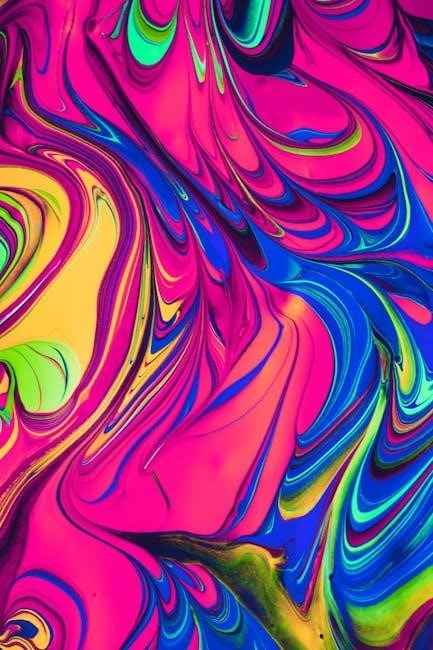The rainbow, as a divine covenant, symbolizes God’s promise of peace and faithfulness. Each color within it carries profound meanings, reflecting themes of redemption, hope, and divine presence.
Overview of Color Symbolism in the Bible
Color symbolism in the Bible is a powerful tool for conveying spiritual truths and divine messages. Each color carries specific meanings, often tied to themes of redemption, royalty, and God’s presence. Red symbolizes sacrifice and redemption, while blue represents royalty and divinity. Yellow signifies light and God’s glory, green embodies life and hope, and purple denotes nobility and spiritual richness. These colors are woven into biblical narratives, rituals, and objects like the tabernacle and royal garments. The rainbow, a vivid display of colors, serves as a covenant symbol of God’s faithfulness. Understanding these hues enriches biblical interpretation, revealing deeper layers of meaning and divine communication.
The Rainbow as a Divine Covenant
The rainbow is a profound symbol of God’s covenant with humanity, signifying divine faithfulness and mercy. In Genesis 9:16, it represents God’s promise to never again destroy the earth by flood. The vibrant colors of the rainbow—red, orange, yellow, green, blue, indigo, and violet—each hold symbolic meanings. Red signifies God’s covenant and sacrifice, while violet represents spiritual fulfillment. The rainbow serves as a visual reminder of God’s enduring promises, bridging heaven and earth. It embodies hope, renewal, and the assurance of divine faithfulness, reinforcing trust in God’s Word and His unchanging nature. The rainbow’s beauty and significance continue to inspire awe and reflection on God’s covenantal love.

The Biblical Meaning of the Rainbow
The rainbow is a divine covenant symbolizing God’s promise of peace and faithfulness. Its vibrant colors represent redemption, hope, and trust in God’s enduring promises, inspiring awe and reflection on His love and mercy.
Genesis 9:16 and the Promise of Peace
Genesis 9:16 establishes the rainbow as a divine covenant, symbolizing God’s promise of peace and faithfulness. The verse emphasizes God’s commitment to never again destroy the earth by flood, reflecting His eternal mercy. The rainbow’s colors—red, orange, yellow, green, blue, indigo, and violet—each carry symbolic meanings tied to redemption, hope, and divine presence. Red signifies sacrifice and covenant, while violet represents spiritual enrichment. This biblical account underscores the rainbow as a universal sign of trust and reconciliation, reminding humanity of God’s unwavering faithfulness and the restoration of harmony between heaven and earth.
The Rainbow as a Symbol of Faithfulness
The rainbow serves as a powerful symbol of God’s faithfulness, reinforcing His covenant with humanity. As described in Genesis, the rainbow appears after the flood, signifying divine mercy and the promise of restoration. Each color within the rainbow carries symbolic meaning, with red often representing sacrifice and covenant, while violet symbolizes spiritual richness. The rainbow’s presence reminds humanity of God’s trustworthiness and His commitment to uphold His promises. It underscores the theme of divine faithfulness, reassuring believers of God’s enduring love and mercy; This visual covenant bridges the gap between heaven and earth, symbolizing hope and renewal.

Color Symbolism in the Bible
Colors in the Bible carry deep spiritual meanings, with red symbolizing redemption, blue representing divinity, and purple signifying nobility. Each hue reflects God’s divine plan and promises.
Red: Symbol of Redemption and Sacrifice
Red holds profound significance in biblical symbolism, representing redemption and sacrifice; It is closely tied to the blood of Christ, which was shed for the forgiveness of humanity’s sins. This color signifies the ultimate act of love and sacrifice, embodying the heart of God’s plan for salvation. Red also symbolizes life and the shedding of blood, as seen in Genesis 9:6, where life is sacred. Additionally, it represents sin and purification, as purification rituals often involved the use of red elements, such as the crimson wool in Leviticus 17:11. Through red, the Bible underscores the cost of redemption and the profound grace offered through Christ’s sacrifice.
Blue: Representing Royalty and Divinity
Blue is a powerful symbol in biblical contexts, representing royalty, divine authority, and heavenly realms. It is often associated with God’s throne, as seen in Exodus 24:10, where the pavement under His feet was like sapphire. Blue also signifies purity and holiness, as evidenced in the intricate designs of the priestly garments and the tabernacle. In Numbers 15:38, the Israelites were instructed to wear tassels with blue threads, reminding them of God’s commandments and divine presence. Blue’s prominence in worship settings underscores its connection to reverence and the majesty of God. This color serves as a visual reminder of God’s sovereign rule and the sacred nature of His relationship with humanity.
Yellow: Signifying Light and God’s Presence
Yellow, often associated with light and divine presence, symbolizes Gods glory and radiant nature. In the Bible, yellow is linked to fire, which represents Gods presence and judgment, as seen in Deuteronomy 4:24 and Hebrews 12:29. This color also signifies joy, anointing, and spiritual light, reflecting Gods active engagement with humanity. In the rainbow, yellow embodies divine light, serving as a reminder of Gods covenant promise. Culturally, yellow has been tied to purification and rejoicing, as in Nehemiah 8:10, where joy is described as strength. Its connection to gold further emphasizes its representation of eternal deity and sanctification, making yellow a powerful symbol of Gods enduring presence and glory.
Green: Symbol of Life and Eternal Hope
Green, a color deeply rooted in nature, symbolizes life, renewal, and eternal hope in biblical contexts. It represents the vitality of Gods creation and the promise of everlasting life through Christ. In Genesis, green appears in the description of the earth after creation, emphasizing fertility and growth. The color also signifies spiritual renewal, as seen in Psalm 92:14, where it speaks of flourishing in old age. Culturally, green has been associated with harmony and balance, reflecting the divine order of creation. Its presence in the rainbow underscores Gods covenant of life and hope, reminding humanity of His faithfulness and the eternal promise of renewal and restoration.
Purple: Representing Nobility and Spiritual Riches
Purple, a color of luxury and majesty, symbolizes nobility and spiritual wealth in biblical contexts. Derived from the rare and costly dye of the murex snail, purple was reserved for royalty and high-ranking officials. In the Bible, it represents divine kingship, as seen in the garments of kings and high priests. Spiritually, purple signifies richness in faith and God’s grace, often associated with the transformation of believers into God’s royal priesthood. Its presence in the rainbow highlights God’s covenant promise, reminding humanity of His faithfulness and the eternal spiritual riches available through Christ. This color bridges earthly majesty with heavenly glory, reflecting the profound depth of God’s relationship with His people.
Cultural and Historical Context of Colors
Cultural practices and historical traditions deeply influenced biblical color symbolism. Ancient rituals and societal values assigned specific meanings to colors, reflecting their spiritual and prophetic significance.
Ancient Practices and Rituals Involving Colors
In biblical times, colors were deeply intertwined with religious rituals and cultural practices. The use of purple dye, for instance, was reserved for royalty due to its rarity and high cost, symbolizing wealth and nobility. Similarly, red was often associated with sacrifice and purification, as seen in the sprinkling of blood in Levitical rituals. These practices not only reflected societal hierarchies but also carried profound spiritual meanings, emphasizing the connection between the physical and divine realms. Such rituals were essential in conveying God’s messages and maintaining covenant relationships, as colors served as visual reminders of His promises and commandments.

Cultural Influences on Color Interpretation
Cultural contexts significantly shaped the interpretation of colors in biblical symbolism. While certain colors held consistent meanings across cultures, others were influenced by local traditions and values. For example, blue was often linked to royalty in many ancient societies, aligning with its biblical association with divinity. Similarly, purple, due to its rarity, universally symbolized nobility and wealth. However, red, while consistently tied to sacrifice and redemption, also carried cultural nuances, such as representing passion or sin in specific communities. These variations highlight how cultural perspectives enriched the tapestry of biblical color symbolism, allowing for diverse yet profound interpretations of God’s messages and promises.

Practical Applications of Biblical Color Study
Biblical color symbolism enriches personal reflection and worship. Using colors like red for redemption or blue for royalty can deepen Bible study and spiritual growth.
Using Color Symbolism for Personal Reflection
Color symbolism offers a profound tool for personal reflection, enabling believers to connect with biblical themes. By meditating on colors like red, symbolizing redemption, or blue, representing royalty, individuals can deepen their spiritual understanding. Yellow, signifying God’s presence, invites joy and light into one’s life. Green, embodying eternal hope, encourages trust in God’s plan. Purple, representing nobility, reminds us of our spiritual riches in Christ. Reflecting on these colors during prayer or journaling can foster a deeper connection to Scripture and its promises, enriching personal faith and spiritual growth.
Enhancing Bible Study with Color Interpretation
Color interpretation deeply enriches Bible study by revealing symbolic meanings embedded in Scripture. By understanding the significance of colors like red, blue, and purple, readers can uncover layered themes and spiritual insights. Tools such as the Rainbow Study Bible, which color-codes verses, help identify recurring motifs. Reflecting on these hues during study fosters a deeper connection to biblical narratives. For instance, red symbolizes redemption, while blue represents royalty, offering fresh perspectives on familiar passages. Incorporating color-coded journals or digital tools can also organize and enhance personal study, making it more engaging and meaningful. This approach invites believers to explore Scripture with renewed depth and understanding.
The rainbow, as a symbol of divine promise, offers profound insights into God’s faithfulness and plan; Color symbolism enriches our understanding of biblical themes and divine covenant.
Final Thoughts on Biblical Color Symbolism
Biblical color symbolism offers a rich tapestry of spiritual insights, connecting us to God’s promises and divine nature. The rainbow, as a covenant, embodies redemption, hope, and faithfulness.
